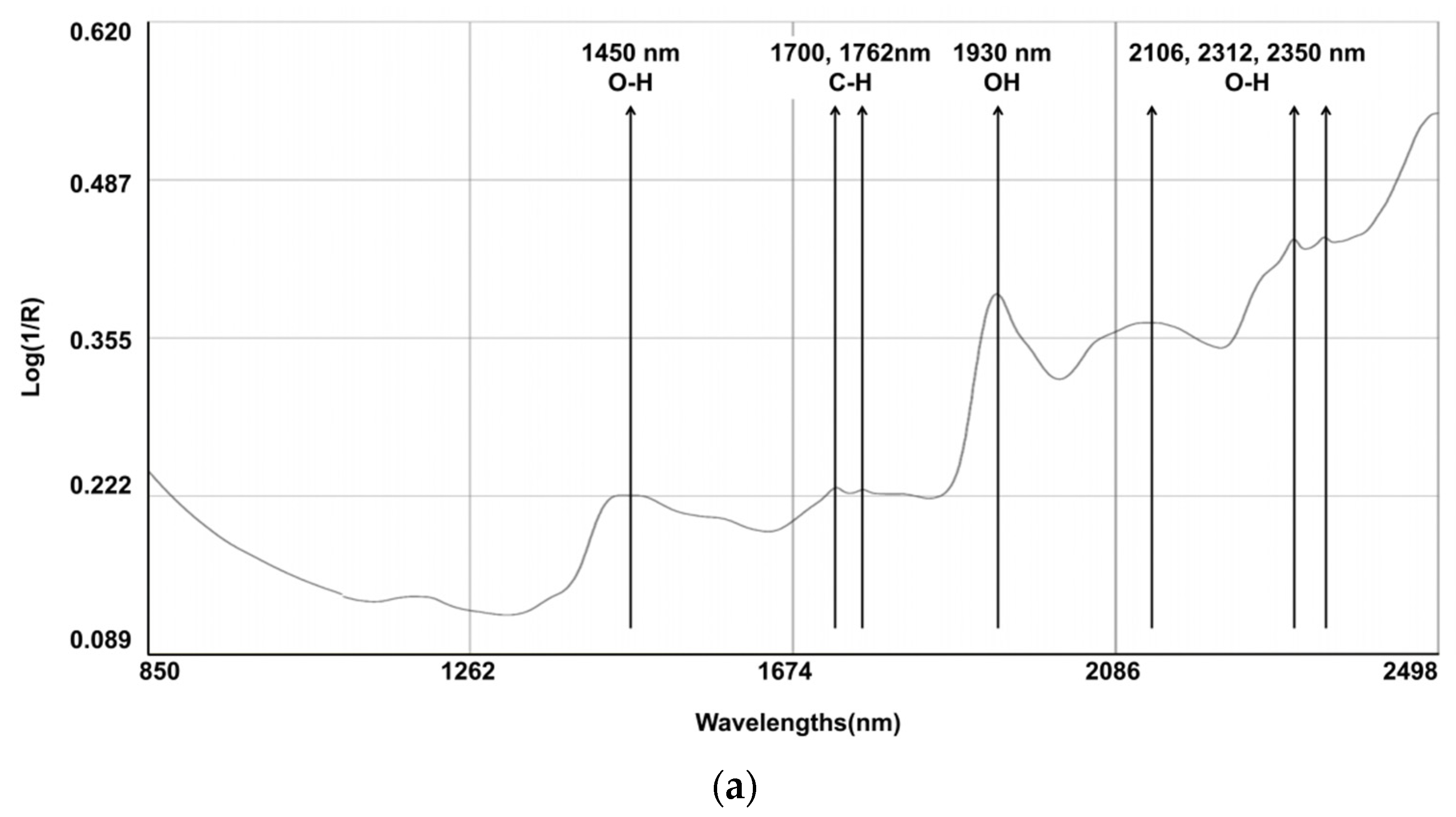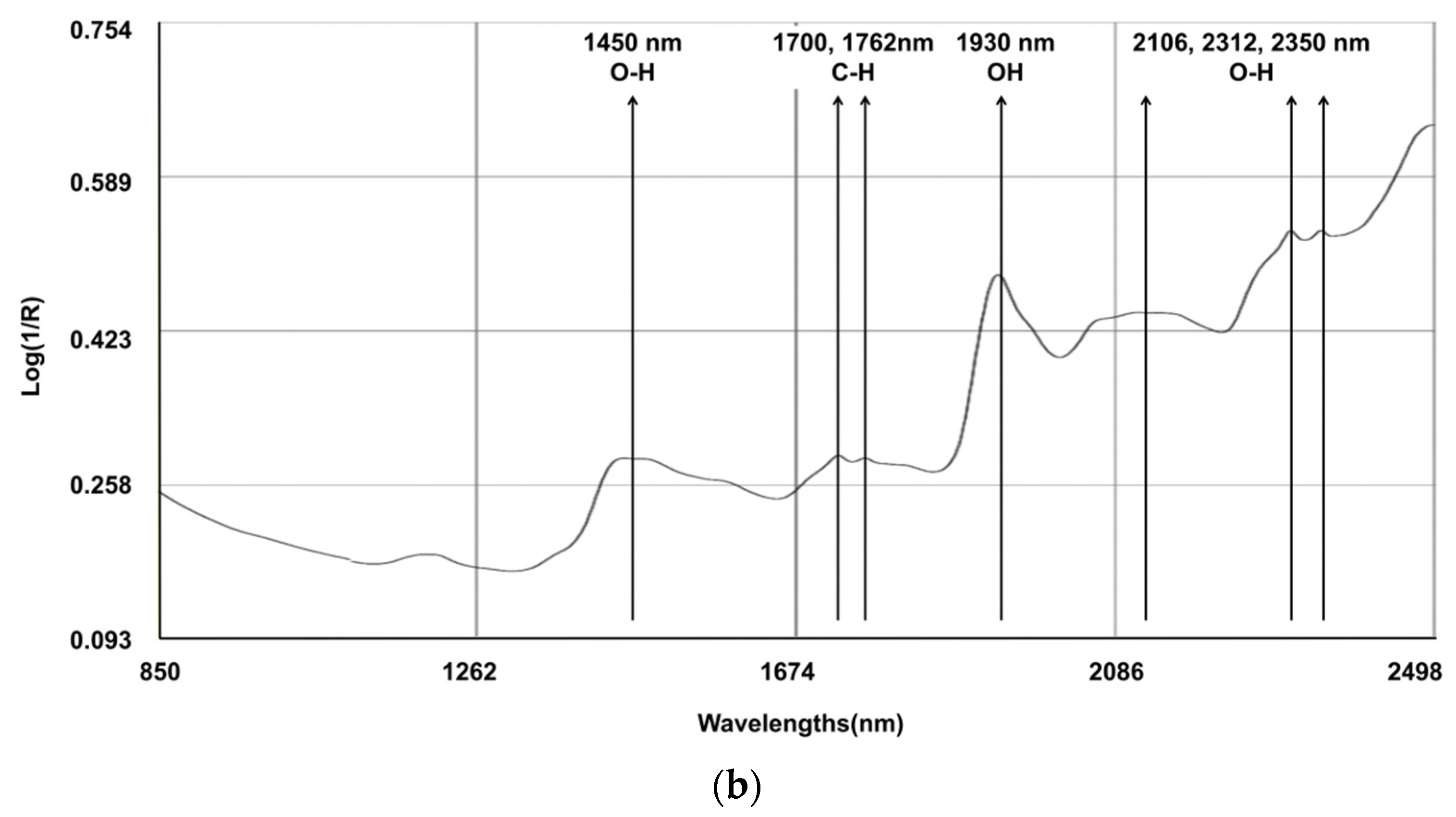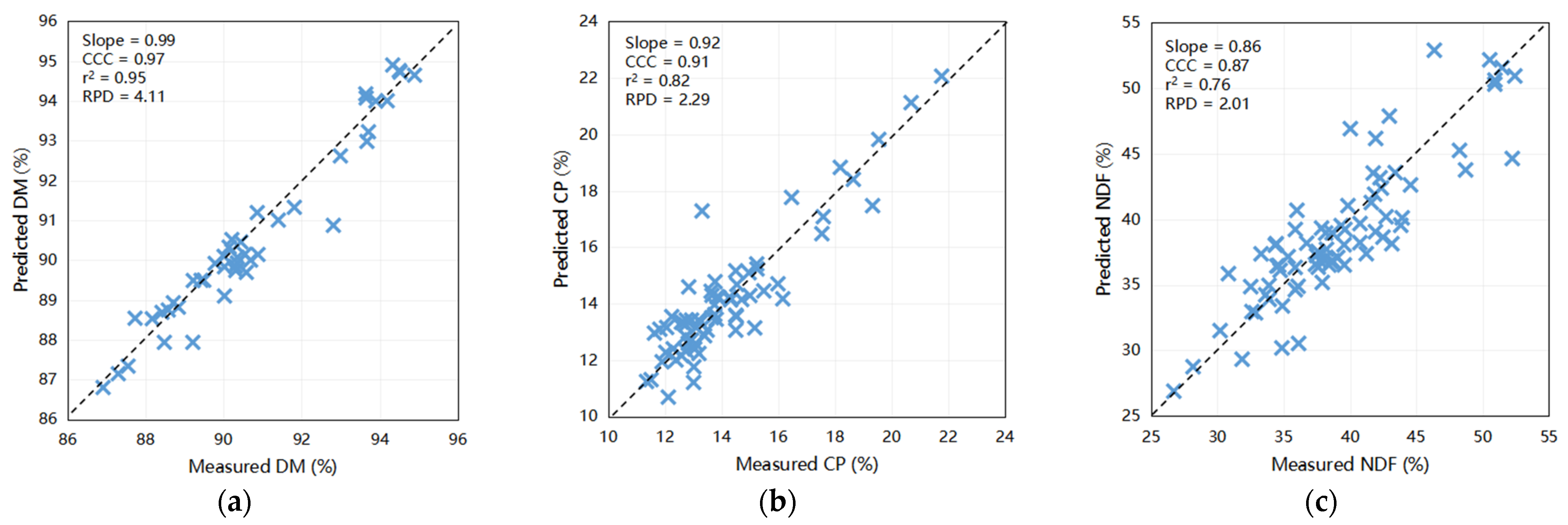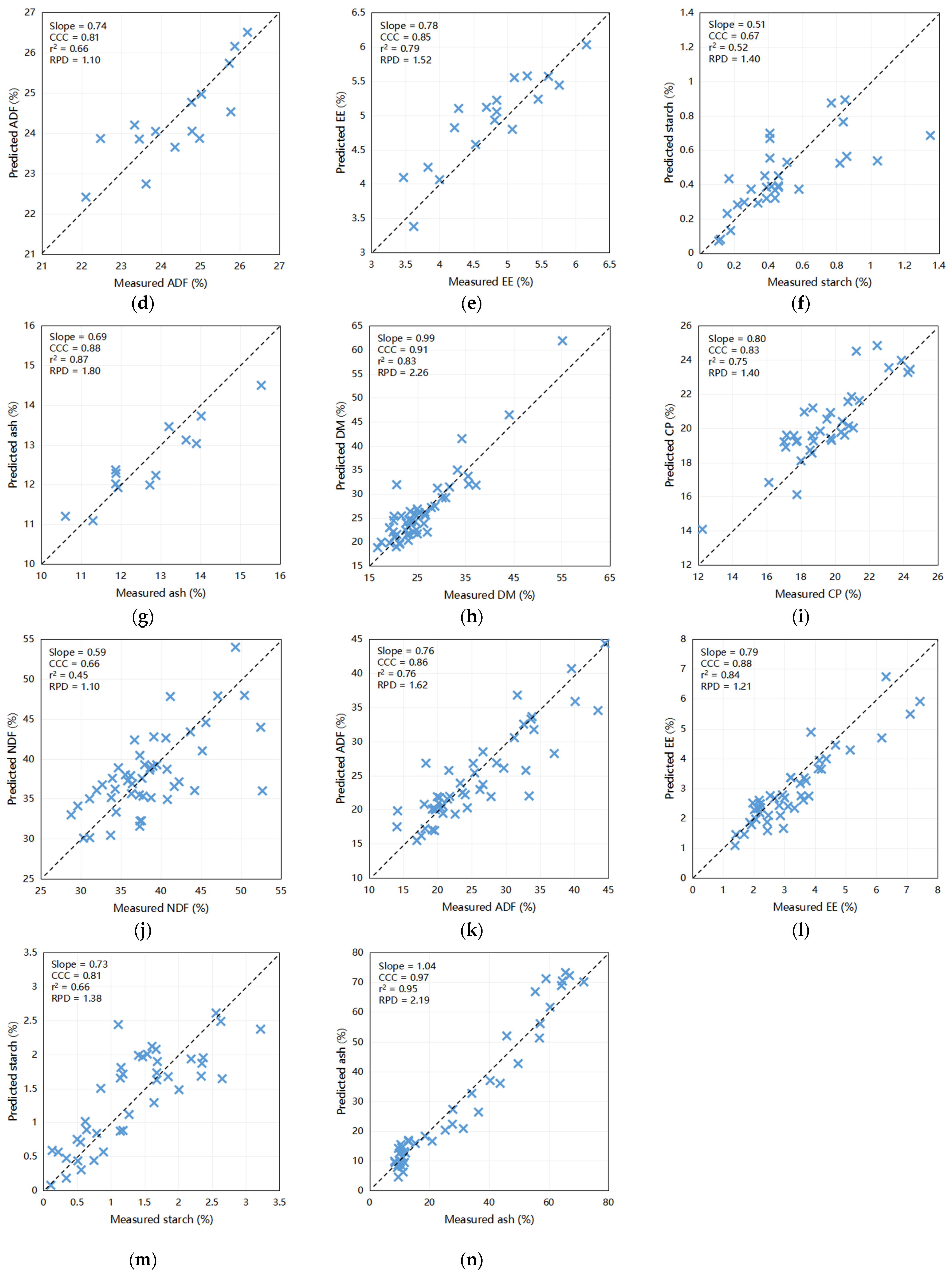Application of Near-Infrared Reflectance Spectroscopy for Predicting Chemical Composition of Feces in Holstein Dairy Cows and Calves
Abstract
:Simple Summary
Abstract
1. Introduction
2. Materials and Methods
2.1. Experimental Animals and Design
2.2. Wet Chemical Analysis of Fecal Samples
2.3. Fecal NIRS Acquisition
2.4. Preprocessing of Spectra, Calibration, and Validation
3. Results
3.1. Sample Composition
3.2. Spectra Editing
3.3. Calibration and Validation of MPLS Models
3.4. Models for Accurate Determination of Compositions from Dairy Fecal Samples
4. Discussion
5. Conclusions
Author Contributions
Funding
Institutional Review Board Statement
Informed Consent Statement
Data Availability Statement
Conflicts of Interest
References
- Hadrich, J.C.; Johnson, K.K. Estimation of risk management effects on revenue and purchased feed costs on US dairy farms. J. Dairy Sci. 2015, 98, 6588–6596. [Google Scholar] [CrossRef] [PubMed]
- Yakubu, H.G.; Kovacs, Z.; Toth, T.; Bazar, G. The recent advances of near-infrared spectroscopy in dairy production—A review. Crit. Rev. Food Sci. Nutr. 2022, 62, 810–831. [Google Scholar] [CrossRef] [PubMed]
- Evangelista, C.; Basiricò, L.; Bernabucci, U. An Overview on the Use of Near Infrared Spectroscopy (NIRS) on Farms for the Management of Dairy Cows. Agriculture 2021, 11, 296. [Google Scholar] [CrossRef]
- Thomson, A.L.; Humphries, D.J.; Rymer, C.; Archer, J.E.; Grant, N.W.; Reynolds, C.K. Assessing the accuracy of current near infra-red reflectance spectroscopy analysis for fresh grass-clover mixture silages and development of new equations for this purpose. Anim. Feed. Sci. Technol. 2018, 239, 94–106. [Google Scholar] [CrossRef]
- Parra-Forero, D.; Valencia-Echavarria, D.M.; Mestra-Vargas, L.I.; Gualdron-Duarte, L.; Sierra-Alarcon, A.M.; Mayorga-Mogollon, O.; Ariza-Nieto, C. Use of near-infrared reflectance spectroscopy on feces to estimate digestibility and dry matter intake of dietary nutritional characteristics under grazing conditions in Colombian creole steers. Trop. Anim. Health Prod. 2023, 55, 178. [Google Scholar] [CrossRef] [PubMed]
- Dixon, R.; Coates, D. Review: Near Infrared Spectroscopy of Faeces to Evaluate the Nutrition and Physiology of Herbivores. J. Near Infrared Spec. 2009, 17, 1–31. [Google Scholar] [CrossRef]
- Johnson, J.R.; Carstens, G.E.; Prince, S.D.; Ominski, K.H.; Wittenberg, K.M.; Undi, M.; Forbes, T.D.A.; Hafla, A.N.; Tolleson, D.R.; Basarab, J.A. Application of fecal near-infrared reflectance spectroscopy profiling for the prediction of diet nutritional characteristics and voluntary intake in beef cattle. J. Anim. Sci. 2017, 95, 447–454. [Google Scholar] [CrossRef]
- Food ChemGarnsworthy, P.C.; Unal, Y. Estimation of dry-matter intake and digestibility in group-fed dairy cows using near infrared reflectance spectroscopy. Anim. Sci. 2016, 79, 327–334. [Google Scholar] [CrossRef]
- Boval, M.; Ortega-Jimenez, E.; Fanchone, A.; Alexandre, G. Diet attributes of lactating ewes at pasture using faecal NIRS and relationship to pasture characteristics and milk production. J. Agric. Sci. 2010, 148, 477–485. [Google Scholar] [CrossRef]
- Schiborra, A.; Bulang, M.; Berk, A.; Susenbeth, A.; Schlecht, E. Using faecal near-infrared spectroscopy (FNIRS) to estimate nutrient digestibility and chemical composition of diets and faeces of growing pigs. Anim. Feed. Sci. Technol. 2015, 210, 234–242. [Google Scholar] [CrossRef]
- Bastianelli, D.; Bonnal, L.; Jaguelin-Peyraud, Y.; Noblet, J. Predicting feed digestibility from NIRS analysis of pig faeces. Animal 2015, 9, 781–786. [Google Scholar] [CrossRef] [PubMed]
- Givens, D.I.; De Boever, J.L.; Deaville, E.R. The principles, practices and some future applications of near infrared spectroscopy for predicting the nutritive value of foods for animals and humans. Nutr. Res. Rev. 1997, 10, 83–114. [Google Scholar] [CrossRef] [PubMed]
- Lestander, T.A.; Rhén, C. Multivariate NIR spectroscopy models for moisture, ash and calorific content in biofuels using bi-orthogonal partial least squares regression. Analyst 2005, 130, 1182–1189. [Google Scholar] [CrossRef] [PubMed]
- Saha, U.; Jackson, D. Analysis of moisture, oil, and fatty acid composition of olives by near-infrared spectroscopy: Development and validation calibration models. J. Sci. Food Agric. 2018, 98, 1821–1831. [Google Scholar] [CrossRef] [PubMed]
- Werther, J.; Saenger, M.; Hartge, E.U. Combustion of agricultural residues. Prog. Energy Combust. Sci. 2000, 26, 1–27. [Google Scholar] [CrossRef]
- Karoui, R.; Baerdemaeker, J.D. A review of the analytical methods coupled with chemometric tools for the determination of the quality and identity of dairy products. Food Chem. 2007, 102, 621–640. [Google Scholar] [CrossRef]
- van Vliet, P.C.J.; Reijs, J.W.; Bloem, J.; Dijkstra, J.; de Goede, R.G.M. Effects of Cow Diet on the Microbial Community and Organic Matter and Nitrogen Content of Feces. J. Dairy Sci. 2007, 90, 5146–5158. [Google Scholar] [CrossRef]
- Landau, S.; Giger-Reverdin, S.; Rapetti, L.; Dvash, L.; Dorléans, M.; Ungar, E.D. Data mining old digestibility trials for nutritional monitoring in confined goats with aids of fecal near infra-red spectrometry. Small Rumin. Res. 2008, 77, 146–158. [Google Scholar] [CrossRef]
- Núnez-Sánchez, N.; Marín, A.L.M.; Hernández, M.P.; Carrion, D.; Castro, G.G.; Alba, L.M.P. Faecal near infrared spectroscopy (NIRS) as a tool to asses rabbit’s feed digestibility. Livest. Sci. 2012, 150, 386–390. [Google Scholar] [CrossRef]
- Kidane, N.F. Fecal Near-Infrared Reflectance Spectroscopy Calibrations for Predicting Diet Quality and Intake of Donkeys. Ph.D. Thesis, Texas A&M University, College Station, TX, USA, 2005. [Google Scholar]
- Zhang, J.; Xu, X.; Cao, Z.; Wang, Y.; Yang, H.; Azarfar, A.; Li, S. Effect of Different Tannin Sources on Nutrient Intake, Digestibility, Performance, Nitrogen Utilization, and Blood Parameters in Dairy Cows. Animals 2019, 9, 507. [Google Scholar] [CrossRef]
- Berbert; Queiroz, D.M.; Melo, E.C. Official Methods of Analysis of AOAC International, 18th ed.; AOAC: Rockville, MD, USA, 2005. [Google Scholar]
- Hall, M.B. Determination of starch, including maltooligosaccharides, in animal feeds: Comparison of methods and a method recommended for AOAC collaborative study. J. AOAC Int. 2009, 92, 42–49. [Google Scholar] [CrossRef] [PubMed]
- Blanco, M.; Villarroya, I. NIR spectroscopy: A rapid-response analytical tool. Trac-Trend Anal. Chem. 2002, 21, 240–250. [Google Scholar] [CrossRef]
- Sorensen, L.K. Prediction of Fermentation Parameters in Grass and Corn Silage by Near Infrared Spectroscopy. J. Dairy Sci. 2004, 87, 3826–3835. [Google Scholar] [CrossRef] [PubMed]
- Stocco, G.; Cipolat-Gotet, C.; Ferragina, A.; Berzaghi, P.; Bittante, G. Accuracy and biases in predicting the chemical and physical traits of many types of cheeses using different visible and near-infrared spectroscopic techniques and spectrum intervals. J. Dairy Sci. 2019, 102, 9622–9638. [Google Scholar] [CrossRef] [PubMed]
- Brogna, N.; Palmonari, A.; Canestrari, G.; Mammi, L.; Dal Pra, A.; Formigoni, A. Technical note: Near infrared reflectance spectroscopy to predict fecal indigestible neutral detergent fiber for dairy cows. J. Dairy Sci. 2018, 101, 1234–1239. [Google Scholar] [CrossRef] [PubMed]
- Sato, T.; Maw, A.A.; Katsuta, M. NIR reflectance spectroscopic analysis of the FA composition in sesame (Sesamum indicum L.) seeds. J. Am. Oil Chem. Soc. 2003, 80, 1157–1161. [Google Scholar] [CrossRef]
- Belanche, A.; Weisbjerg, M.R.; Allison, G.G.; Newbold, C.J.; Moorby, J.M. Measurement of rumen dry matter and neutral detergent fiber degradability of feeds by Fourier-transform infrared spectroscopy. J. Dairy Sci. 2014, 97, 2361–2375. [Google Scholar] [CrossRef] [PubMed]
- Campo, L.; Monteagudo, A.B.; Salleres, B.; Castro, P.; Moreno-Gonzalez, J. NIRS determination of non-structural carbohydrates, water soluble carbohydrates and other nutritive quality traits in whole plant maize with wide range variability. Span. J. Agric. Res. 2013, 11, 463–471. [Google Scholar] [CrossRef]
- Arndt, C.; Powell, J.M.; Aguerre, M.J.; Crump, P.M.; Wattiaux, M.A. Feed conversion efficiency in dairy cows: Repeatability, variation in digestion and metabolism of energy and nitrogen, and ruminal methanogens. J. Dairy Sci. 2015, 98, 3938–3950. [Google Scholar] [CrossRef]
- Cavallini, D.; Raspa, F.; Marliani, G.; Nannoni, E.; Martelli, G.; Sardi, L.; Valle, E.; Pollesel, M.; Tassinari, M.; Buonaiuto, G. Growth Performance and Feed Intake Assessment of Italian Holstein Calves Fed a Hay-Based Total Mixed Ration: Preliminary Steps towards a Prediction Model. Vet. Sci. 2023, 10, 554. [Google Scholar] [CrossRef]
- Villamuelas, M.; Serrano, E.; Espunyes, J.; Fernandez, N.; Lopez-Olvera, J.R.; Garel, M.; Santos, J.; Parra-Aguado, M.A.; Ramanzin, M.; Fernandez-Aguilar, X.; et al. Predicting herbivore faecal nitrogen using a multispecies near-infrared reflectance spectroscopy calibration. PLoS ONE 2017, 12, e0176635. [Google Scholar] [CrossRef] [PubMed]
- Coleman, S.W.; Murray, I. The use of near-infrared reflectance spectroscopy to define nutrient digestion of hay by cattle. Anim. Feed. Sci. Technol. 1993, 44, 237–249. [Google Scholar] [CrossRef]
- Althaus, B.; Papke, G.; Sundrum, A. Technical note: Use of near infrared reflectance spectroscopy to assess nitrogen and carbon fractions in dairy cow feces. Anim. Feed. Sci. Technol. 2013, 185, 53–59. [Google Scholar] [CrossRef]
- Iii, J.B.R.; Kessel, J.S.V. Near-Infrared Spectroscopic Determination of Carbon, Total Nitrogen, and Ammonium-N in Dairy Manures. J. Dairy Sci. 2000, 83, 1829–1836. [Google Scholar]
- Cozzolino, D.; La Manna, A.; Martins, D.V. Use of near Infrared Reflectance Spectroscopy to Analyse Bovine Faecal Samples. J. Near Infrared Spec. 2002, 10, 309–314. [Google Scholar] [CrossRef]
- Nirea, K.G.; Perez de Nanclares, M.; Skugor, A.; Afseth, N.K.; Meuwissen, T.H.E.; Hansen, J.O.; Mydland, L.T.; Overland, M. Assessment of fecal near-infrared spectroscopy to predict feces chemical composition and apparent total-tract digestibility of nutrients in pigs. J. Anim. Sci. 2018, 96, 2826–2837. [Google Scholar] [CrossRef] [PubMed]
- Landau, S.Y.; Dvash, L.; Roudman, M.; Muklada, H.; Barkai, D.; Yehuda, Y.; Ungar, E.D. Faecal near-IR spectroscopy to determine the nutritional value of diets consumed by beef cattle in east Mediterranean rangelands. Animal 2016, 10, 192–202. [Google Scholar] [CrossRef] [PubMed]
- Hayes, D.J. Development of near infrared spectroscopy models for the quantitative prediction of the lignocellulosic components of wet Miscanthus samples. Bioresour. Technol. 2012, 119, 393–405. [Google Scholar] [CrossRef]
- Mehtio, T.; Rinne, M.; Nyholm, L.; Mantysaari, P.; Sairanen, A.; Mantysaari, E.A.; Pitkanen, T.; Lidauer, M.H. Cow-specific diet digestibility predictions based on near-infrared reflectance spectroscopy scans of faecal samples. J. Anim. Breed. Genet. 2016, 133, 115–125. [Google Scholar] [CrossRef]
- Fredin, S.M.; Ferraretto, L.F.; Akins, M.S.; Hoffman, P.C.; Shaver, R.D. Fecal starch as an indicator of total-tract starch digestibility by lactating dairy cows. J. Dairy Sci. 2014, 97, 1862–1871. [Google Scholar] [CrossRef]
- Mentink, R.L.; Hoffman, P.C.; Bauman, L.M. Utility of near-infrared reflectance spectroscopy to predict nutrient composition and in vitro digestibility of total mixed rations. J. Dairy Sci. 2006, 89, 2320–2326. [Google Scholar] [CrossRef] [PubMed]
- Parrini, S.; Acciaioli, A.; Crovetti, A.; Bozzi, R. Use of FT-NIRS for determination of chemical components and nutritional value of natural pasture. Ital. J. Anim. Sci. 2017, 17, 87–91. [Google Scholar] [CrossRef]
- Modrono, S.; Soldado, A.; Martinez-Fernandez, A.; de la Roza-Delgado, B. Handheld NIRS sensors for routine compound feed quality control: Real time analysis and field monitoring. Talanta 2017, 162, 597–603. [Google Scholar] [CrossRef] [PubMed]




| Trial | 1 | 2 | 3 | 4 | ||||
|---|---|---|---|---|---|---|---|---|
| N 1 | 40 | 13 | 55 | 36 | 50 | 68 | 67 | 213 |
| Location | Beijing | Baoji, Shaanxi | Daqing, Heilongjiang | Harbin, Heilongjiang | Beijing | Hefei, Anhui | Hefei, Anhui | Baoji, Shaanxi |
| Period | Peak lactating | Peak lactating | Peak lactating | Peak lactating | Mid lactating | Fresh | Peak lactating | Pre-weaning calf stage |
| Body weight, kg | 647.50 | 617.20 | 719.30 | 734.50 | 675.50 | 687.70 | 679.40 | 80.70 |
| Milk yield, kg/d | 41.10 | 46.30 | 48.20 | 51.10 | 36.30 | 32.60 | 38.20 | - |
| Fecal chemical composition 2 | DM, CP, NDF, Starch | DM, CP, EE, NDF, ADF, Ash | DM, CP, EE, NDF, ADF, Ash | DM, CP, EE, NDF, ADF, Starch, Ash | ||||
| Dietary components, % of DM unless otherwise noted | ||||||||
| DM, % | 49.05 | 50.67 | 47.54 | 50.83 | 50.71 | 46.16 | 47.28 | 14.67 |
| CP | 16.71 | 19.43 | 18.08 | 18.79 | 18.80 | 16.64 | 17.17 | 22.30 |
| NDF | 26.21 | 27.22 | 23.72 | 32.94 | 49.27 | 32.71 | 31.05 | - |
| EE | 3.17 | 3.56 | 3.21 | 4.81 | 2.62 | 4.27 | 4.64 | 18.03 |
| Starch | 16.17 | 16.86 | 17.94 | 18.15 | 13.57 | 25.95 | 29.38 | - |
| Ash | 7.89 | 6.21 | 6.14 | 7.73 | 7.44 | 8.49 | 7.83 | - |
| Group | Chemical Composition 1 | Calibration Data Set | Validation Data Set | ||||
|---|---|---|---|---|---|---|---|
| n 2 | Mean | SD 3 | n 2 | Mean | SD 3 | ||
| Cows | DM (%) | 128 | 16.86 | 1.33 | 44 | 16.80 | 1.12 |
| CP (% of DM) | 197 | 14.08 | 2.60 | 68 | 14.15 | 2.21 | |
| NDF (% of DM) | 218 | 38.43 | 5.98 | 75 | 39.13 | 5.59 | |
| ADF (% of DM) | 39 | 23.99 | 1.83 | 15 | 24.63 | 1.85 | |
| EE (% of DM) | 54 | 4.84 | 1.05 | 18 | 4.75 | 0.75 | |
| Starch (% of DM) | 92 | 0.35 | 0.23 | 30 | 0.49 | 0.29 | |
| Ash (% of DM) | 41 | 12.09 | 0.91 | 13 | 12.72 | 1.33 | |
| Calves | DM (%) | 145 | 25.18 | 6.88 | 51 | 25.82 | 7.49 |
| CP (% of DM) | 99 | 19.99 | 2.45 | 35 | 19.39 | 2.29 | |
| NDF (% of DM) | 135 | 38.26 | 6.46 | 48 | 38.65 | 4.99 | |
| ADF (% of DM) | 128 | 24.44 | 8.02 | 47 | 25.85 | 6.66 | |
| EE (% of DM) | 128 | 2.65 | 1.46 | 44 | 3.18 | 1.13 | |
| Starch (% of DM) | 119 | 1.31 | 0.82 | 41 | 1.38 | 0.71 | |
| Ash (% of DM) | 124 | 18.90 | 22.07 | 44 | 28.90 | 28.20 | |
| Group | Chemical Composition 1 | Math Treatment 2 | Scatter Correction 3 | Calibration Statistics 4 | Cross-Validation Statistics 5 | ||
|---|---|---|---|---|---|---|---|
| SEC | RSQ | SECV | 1-VR | ||||
| Cows | DM | 1,8,8,1 | D | 0.34 | 0.98 | 0.39 | 0.97 |
| CP | 1,4,4,1 | SNV | 0.69 | 0.93 | 0.78 | 0.91 | |
| NDF | 1,8,8,1 | SNV | 2.44 | 0.82 | 2.60 | 0.79 | |
| ADF | 1,4,4,1 | SNV + D | 0.89 | 0.74 | 1.21 | 0.56 | |
| EE | 1,4,4,1 | MSC | 0.26 | 0.91 | 0.29 | 0.89 | |
| Starch | 1,4,4,1 | D | 0.10 | 0.79 | 0.12 | 0.70 | |
| Ash | 1,4,4,1 | NO | 0.37 | 0.84 | 0.57 | 0.61 | |
| Calves | DM | 2,4,4,1 | SNV + D | 1.86 | 0.92 | 2.38 | 0.86 |
| CP | 1,8,8,1 | SNV + D | 0.82 | 0.89 | 0.98 | 0.84 | |
| NDF | 2,4,4,1 | SNV + D | 3.01 | 0.76 | 4.12 | 0.55 | |
| ADF | 1,4,4,1 | SNV + D | 2.21 | 0.92 | 3.05 | 0.86 | |
| EE | 1,4,4,1 | D | 0.42 | 0.77 | 0.51 | 0.67 | |
| Starch | 2,4,4,1 | SNV + D | 0.43 | 0.73 | 0.47 | 0.68 | |
| Ash | 1,4,4,1 | SNV + D | 2.51 | 0.97 | 3.19 | 0.96 | |
Disclaimer/Publisher’s Note: The statements, opinions and data contained in all publications are solely those of the individual author(s) and contributor(s) and not of MDPI and/or the editor(s). MDPI and/or the editor(s) disclaim responsibility for any injury to people or property resulting from any ideas, methods, instructions or products referred to in the content. |
© 2023 by the authors. Licensee MDPI, Basel, Switzerland. This article is an open access article distributed under the terms and conditions of the Creative Commons Attribution (CC BY) license (https://creativecommons.org/licenses/by/4.0/).
Share and Cite
Xu, Y.; Chen, T.; Zhang, H.; Nuermaimaiti, Y.; Zhang, S.; Wang, F.; Xiao, J.; Liu, S.; Shao, W.; Cao, Z.; et al. Application of Near-Infrared Reflectance Spectroscopy for Predicting Chemical Composition of Feces in Holstein Dairy Cows and Calves. Animals 2024, 14, 52. https://doi.org/10.3390/ani14010052
Xu Y, Chen T, Zhang H, Nuermaimaiti Y, Zhang S, Wang F, Xiao J, Liu S, Shao W, Cao Z, et al. Application of Near-Infrared Reflectance Spectroscopy for Predicting Chemical Composition of Feces in Holstein Dairy Cows and Calves. Animals. 2024; 14(1):52. https://doi.org/10.3390/ani14010052
Chicago/Turabian StyleXu, Yiming, Tianyu Chen, Hongxing Zhang, Yiliyaer Nuermaimaiti, Siyuan Zhang, Fei Wang, Jianxin Xiao, Shuai Liu, Wei Shao, Zhijun Cao, and et al. 2024. "Application of Near-Infrared Reflectance Spectroscopy for Predicting Chemical Composition of Feces in Holstein Dairy Cows and Calves" Animals 14, no. 1: 52. https://doi.org/10.3390/ani14010052
APA StyleXu, Y., Chen, T., Zhang, H., Nuermaimaiti, Y., Zhang, S., Wang, F., Xiao, J., Liu, S., Shao, W., Cao, Z., Wang, J., & Chen, Y. (2024). Application of Near-Infrared Reflectance Spectroscopy for Predicting Chemical Composition of Feces in Holstein Dairy Cows and Calves. Animals, 14(1), 52. https://doi.org/10.3390/ani14010052







